
Search
Category
Area
Season
-
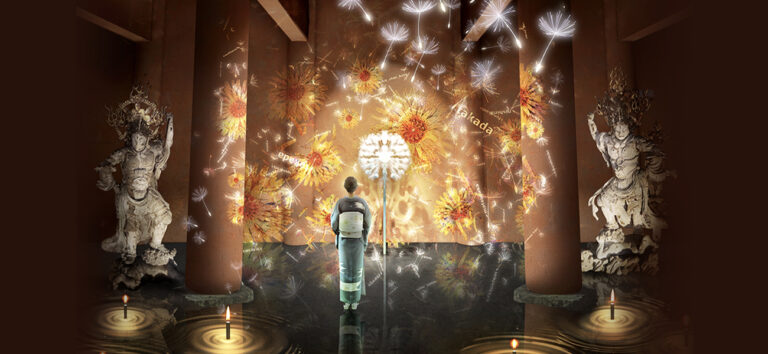
Revealing the Shaka Nyorai Buddha Statue of the Inner Sanctuary and the Western Pagoda of the Shakyamuni Hall
In the spirit of Tendai Buddhism's "Light Up Your Corner," which advocates becoming a positive influence in your corner of the world, Mt. Hiei's Enryakuji Temple will be hosting an annual interdenominational religious summit for world peace. This year, to commemorate the 30th anniversary of Enryakuji Temple's registration as a World Heritage site, a special exhibition will be held for the first time in seven years in the Shakyamuni Hall, the temple's oldest extant building. The previous public viewing of the cloistered statue of Shaka Nyorai Buddha—33 years after its initial opening—was attended by over 100,000 people.
This time, in addition to the revealing of the main statue of Shaka Nyorai in the inner sanctuary, there will also be a special DANDELION PROJECT exhibition, a participatory art project by artist Ryotaro Muramatsu based on the idea of connecting the world with transcendental prayers for peace. Stand in front of the DANDELION art installation amidst the soft candlelit interior of the Shakyamuni Hall and blow dandelion seeds carrying prayers for peace along the wall through projection mapping. Experience a new world of Buddhism through the latest in digital art technology at the Enryakuji Temple's oldest building.
Enryakuji Temple has long sent messages of peace to connect people. Now it will preserve history and transmit this desire for peace to the next generation through art, which is capable of communicating beyond words. -
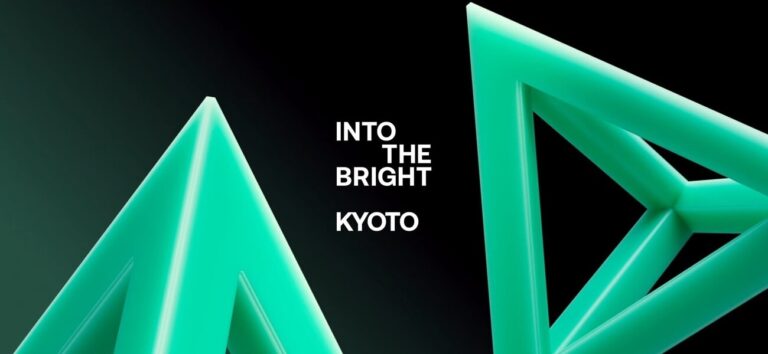
INTO THE BRIGHT - KYOTO
INTO THE BRIGHT - KYOTO is an international forum in Kyoto that brings together global leaders to explore the philosophy of Japan. As an island nation, Japan has long embraced diverse cultures, people, and ideas — at times adopting them directly and at other times transforming them to create something entirely new. This approach has fostered a unique culture built on acceptance and openness.
In today's divided world, the spirit of Japanese tolerance offers a valuable perspective for global leaders working to solve complex social issues. INTO THE BRIGHT - KYOTO offers an interactive program of exchanges with global entrepreneurs and thought leaders, providing an opportunity for meaningful connections and insights. -
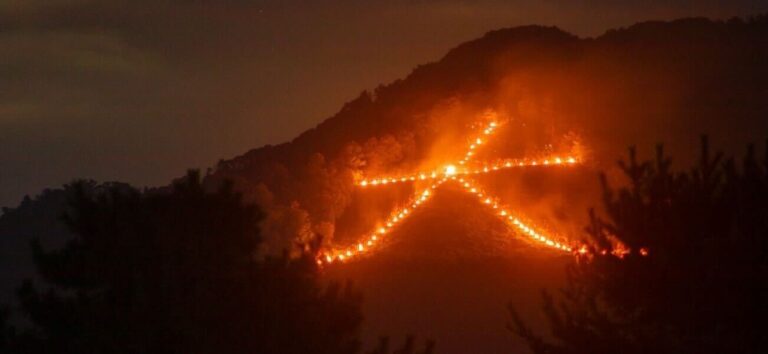
A Day to Experience the Kyoto Gozan Okuribi Ritual Bonfires
The Kyoto Gozan Okuribi (lighting of ritual bonfires on the five mountains of Kyoto), which light up the summer in Kyoto along with the famous Gion Festival, has long been appreciated for its dynamism with large, blazing Japanese characters written with fire on the mountainside. The Gozan Okuribi event was not originally intended as a visual spectacle, but rather to see off the spirits of ancestors as they return to the afterlife at the end of their visit back to this world during the Bon Festival. For this reason, the five mountains where the bonfires are lit are considered sacred, and the public is not permitted to enter them, especially on days when the fires are lit.
For the first time ever, visitors will be able to go to the mountainsides on the day of the event, and experience the history, origin, and customs of each mountain, as well as observe the fire beds, so that they can learn more about the Kyoto Gozan Okuribi ritual. The same evening, visitors will also stop by the former Shimogamo Villa of the Mitsui family, an Important Cultural Property, and the Komai Residence, a Registered Tangible Cultural Property. Both facilities will be booked out exclusively for tour participants during times when they are normally closed, so that they can witness the actual lighting of the bonfires (from both facilities, you can see the lighting of the huge, blazing characters) alongside commentary from expert guides.
There is also the Kyoto Gozan Okuribi Stamp Rally, which involves visiting shrine facilities and collecting a special red stamp at each of the Kyoto Gozan Okuribi mountains. The stamp rally is held in cooperation with cab operators and commercial facilities, and it will give participants various opportunities to experience and learn more about the Kyoto Gozan Okuribi ritual bonfires. -
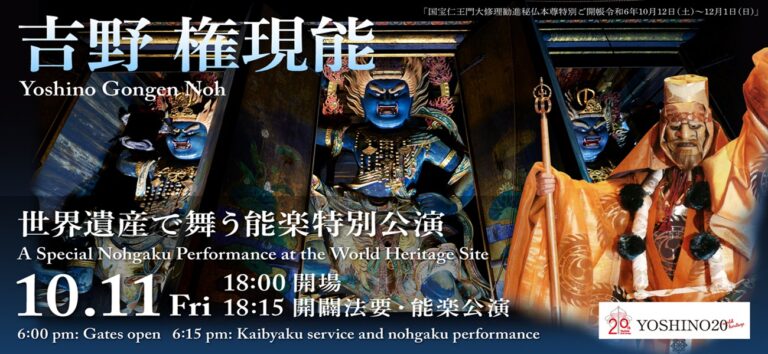
A Gongen Noh Experience Limited to Overnight Guests: Special Noh Theater Performance at a World Heritage Site & Workshop to Learn About Noh with a Living National Treasure
- This year, a Noh performance limited to an audience of 100 people will be held to commemorate the 20th anniversary of Yoshino's registration as a World Heritage Site.
- Participants attending the Noh performance will be able to witness the special viewing of Kongo Zao Daigongen, the largest ""hidden"" Buddhist statues in Japan, which are held in Zaodo Hall at the National Treasure and World Heritage Site, Kinpusenji Temple.
- At night, Zaodo Hall at Kinpusenji Temple will be privately booked out for staging Noh, a traditional Japanese performing art which is UNESCO Intangible Cultural Heritage. It will be performed by Living National Treasures Bunzo Otsuki and Genjiro Okura.
- The Noh play performed will be ""Taniko,"" which expresses the profundity of the Shugendo mountain ascetic faith. This special nighttime performance can only be experienced on this date, in this place.
- On the following day, participants can take part in a workshop to learn the traditional Japanese performing art of Noh theater, taught by Living National Treasure Genjiro Okura and Kiyomasa Kanze. This workshop is only available for the 30 guests staying at Yoshino. -
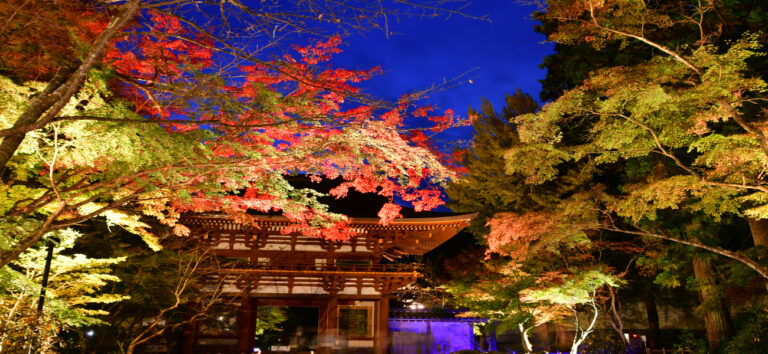
Premium Tour Featuring the Traditional Performing Art of Kyogen at Muroji, A Temple Famous for Extraordinary Autumn Foliage
Avoid the crowds and enjoy a relaxing experience of the superb autumn foliage in Japan's ancient capital of Nara!
Built about 1,400 years ago, Muroji Temple is the only temple of Koyasan that permitted women to visit since ancient times. It is popular as a secluded spot for viewing the autumn leaves in Nara.
This year, for the first time, Muroji Temple will open its main hall—a national treasure normally closed to the public—as a stage for a premium tour that includes a performance of Kyogen theater, one of Japan's classic performing arts, presented by the Izumi school.
In addition to the main hall, visitors will be guided by a priest on a special night tour of the temple grounds, which includes national treasures like the Kondo (main hall) and a five-story pagoda. They will then be treated to a performance of Kyogen by Motoya Izumi, the 20th generation headmaster of the Izumi school, who performs both in Japan and overseas. A special dinner plan showcasing Nara's traditional vegetables (available Nov. 25–26), and a plan featuring a performance by Japan's only female Kyogen performers (Nov. 23–24) will also be available—a fitting performance for Muroji Temple and its strong affiliation with women.
A month-long autumn foliage festival and illumination event will be held starting November 1. Come and enjoy the beautiful autumn leaves and appreciate the essence of traditional Japanese culture. -
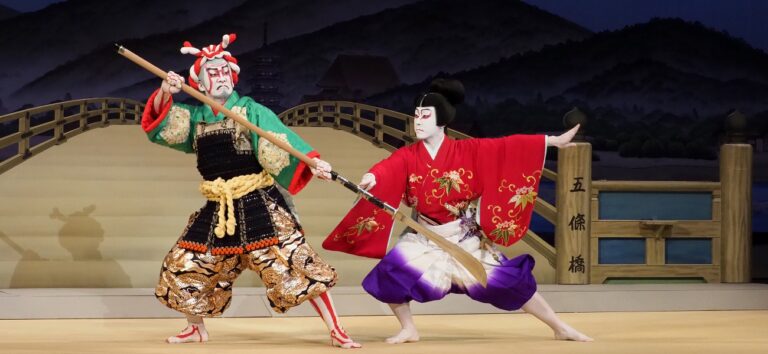
FIRST-TIME KABUKI at Kyoto Station Building
Kabuki is one of Japan's leading forms of traditional theatrical performance. Its origins can be traced back to the early Edo period (early 17th century) when the Kabuki Odori dance was first performed in Kyoto.
First-Time Kabuki is a one-hour kabuki experience and explanation event for all first-time kabuki viewers. It concludes with the performance of a famous scene, set on the Gojo Bridge near Kyoto Station.
Come and enjoy the world of kabuki, a form of Japanese culture that has endured for over 400 years, in Kyoto—the birthplace of Kabuki!
(1) Kyoto Station venue means easy access!
(2) Night shows held daily at 5:30 p.m. and 8 p.m.!
(3) Free rental for audio guides in English, Chinese, and Korean! -
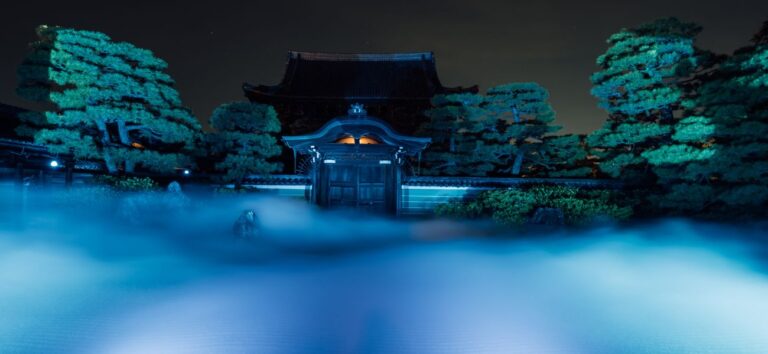
Kenninji Temple, Kyoto: Premium night viewing in the refreshing cool of evening ZEN NIGHT WALK KYOTO
Premium night viewing at Kenninji Temple, the oldest Zen temple in Kyoto
A special nighttime viewing will be held at Kenninji Temple, the oldest Zen temple in Kyoto. During this event, visitors can experience the spirit of Zen by walking through the temple’s corridors while listening to ""neuro-music"" scientifically proven to relax the brain.
Sound Corridors: Neuro-music
Walk through the corridors of Kenninji Temple while listening to ""neuro-music."" This music relaxes the brain, leading to a more mindful state.
Daiyuen Garden - Sokai (Vast ocean)
A sea of clouds appears in Kenninji's dry landscape garden, the Daiyuen Garden, on cool summer nights. This sea of clouds complements the beauty and serenity of the garden as visitors listen to neuro-music.
Twin Dragons & Digital Twin Dragons
Kenninji's iconic Twin Dragons painting, combined with the latest in projection art. Contemporary artist Rei Wakita will use the latest technology to visualize the flow of the dragons’ energy.
Japanese Garden Sound-Art Night Walk
Enjoy art installations of sound and light while touring the corridors of extraordinary Japanese gardens: the Circle-Triangle-Square Garden, the Cho-on-tei Garden, and the Daiyuen Garden.
A truly special evening experience of sound and silence, light and shadow. Experience the fusion of contemporary art and technology while enjoying the history and beauty of Kenninji Temple. -
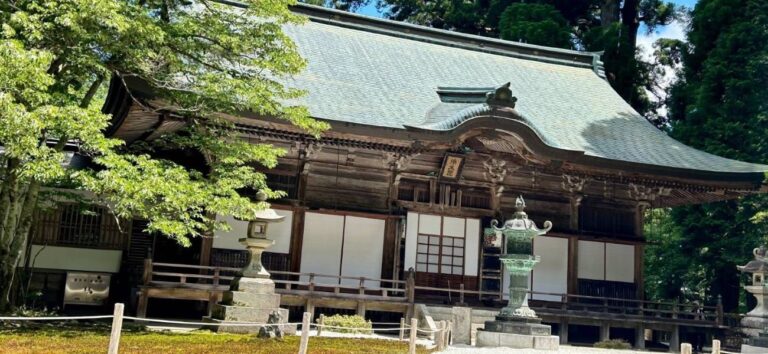
Tailored ascetic training experience at the World Heritage site of Mt. Hiei Enryakuji Temple
Enryakuji Temple on Mt. Hiei is a religious institution that is renowned for producing famous monks, such as Honen and Shinran, from various schools of Japanese Buddhism. Many monks continue to engage in various forms of ascetic practices on the temple grounds.
The experience involves the following:
・ Participants will be guided by the chief priest (the current instructor of monks-in-training) of Enryakuji Temple, one of the most famous Buddhist monasteries in Japan and a World Heritage Site.
・ Each participant will speak with the chief priest, who will ask about their daily thoughts and worries to determine the most suitable training.
・ The training is identical to that practiced by many monks today:
- Circle the mountain in kaihogyo, an ascetic practice that has performed by monks at Mt.Hiei for the past 1100 years
- Practice seated hoto-zazen meditation while visualizing the 1,200-year ""eternal flame of Buddhism""
- Clean the temple grounds and dojo to clear your mind and attain a meditative state
- Recite the name of Amitabha Buddha in Amitabha samadhi, one of the four kinds of samadhi practiced on Mt. Hiei
In contrast to the tourist-oriented training experiences of the past, we offer an authentic training experience in which participants will attain new understanding and insights. -
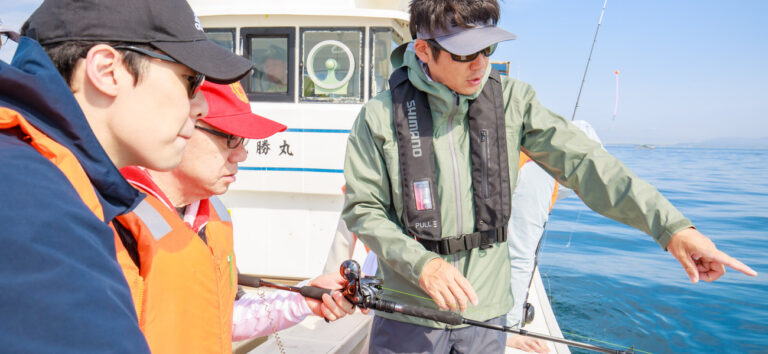
A Fishing Tour Where You Will Learn How to Maneuver a Boat, Read the Tides, and Catch Fish
● Even beginners have a high chance of catching fish, as you will be accompanied by highly skilled boatmen and professional anglers certified by fishing tackle manufacturer Shimano.
● All fishing equipment is provided: you can show up to the tour empty-handed!
● Any fresh fish you catch will be cooked and served to you at the restaurant.
● Stay at a five-star hotel in the Umeda or Namba areas of Osaka.
● Take a hired car to and from the hotel to the fishing port.
● Enjoy shopping at a popular roadside station in Misaki, where you can buy fresh local vegetables and fish. -
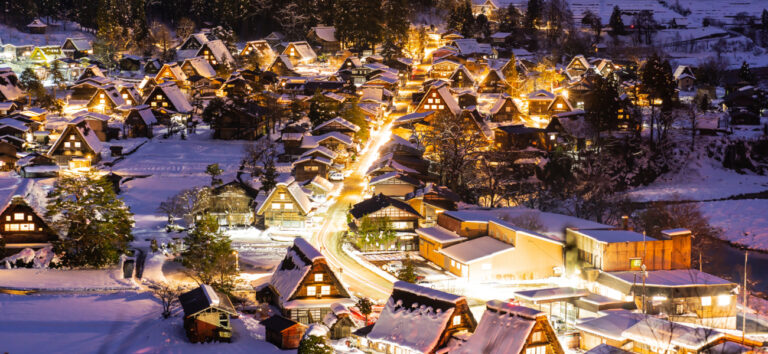
Tour for Luxury Tourists: “The Path of the Craftsman—A Journey Through the Heart of Japan”
This tour is an in-depth experience of traditional Japanese crafts, natural landscapes, and culinary culture unique to various areas. The following unique experiences will be offered in the Aichi, Gifu, and Kyoto Prefectures.
(1) Traditional folk craft experiences
- Ceramic art: Learn from the direct apprentice of a Living National Treasure at the Kobeigama Kiln for an authentic Japanese experience. This activity is exclusive to participants of this tour, and the items can be mailed back to your home countries at a later date.
- Small blade making: Try your hand at making a small blade in a workshop not usually open to the public in Seki, Gifu Prefecture. This experience is also exclusive to participants of this tour, and items can be mailed back to your home countries at a later date.
- Mino-washi papermaking: Learn from an artisan how to make hon-minoshi paper, a method which is registered as an Intangible Cultural Heritage by UNESCO.
(2) Traditional scenery and accommodations
- Tour historical buildings: Visit traditional buildings in places like Gifu Prefecture's Takayama City, Mino City, and Shirakawa-go, as well as Kyoto Prefecture's Kyoto City. Enjoy strolling around and taking photos wearing a kimono.
- Traditional accommodations: Stay in select accommodations in old private homes built more than 130 years ago, or in machiya-style townhouses designated as Important Cultural Properties by the Japanese government. Enjoy an extraordinary experience in a truly special space.
(3) Culinary culture and seasonal produce
- Michelin Guide-listed restaurants: Enjoy dishes made with seasonal local ingredients, such as wild vegetables in spring, ayu (sweetfish) and eel in summer, matsutake mushrooms in fall, and wild game in winter. Accommodations can also be made for vegan or halal dining.
Participants will be accompanied by a guide from the region who is fluent in the participants' language, has extensive knowledge of the area, and who can provide a deeper understanding of Japanese culture.
